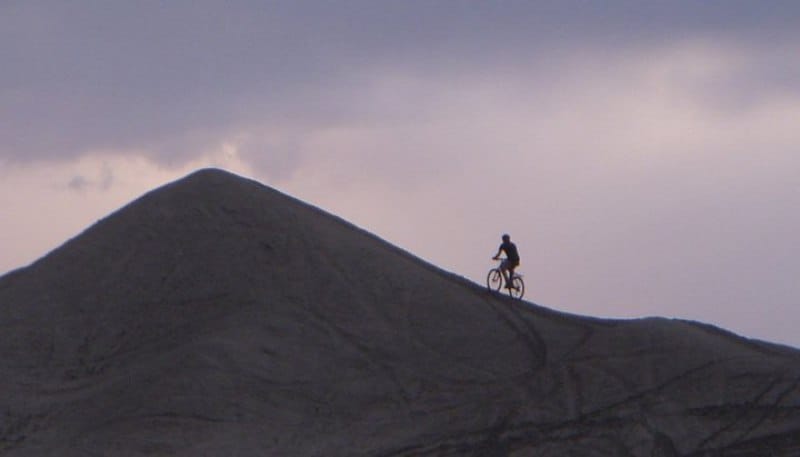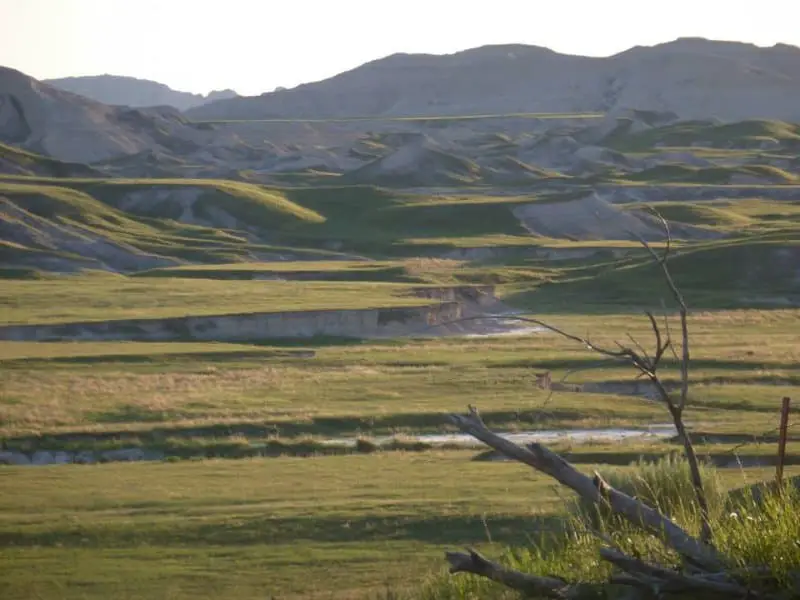I was 18, and sandwiched between homework and theatre club, I was embroiled in an existential identity crisis. One night, after tossing and turning until 1:00 p.m., I sat up in bed and announced to my empty dorm room, “I’m going to bike to the Pacific Ocean.”
Had I ever biked across the country before? No. Did I own a bike capable of the journey? No. Did I have any money? Certainly you jest!
But nine months later, I mounted a secondhand Trek 8000, stuffed an army-surplus sleeping bag into a Hefty bag, and zoomed into the Western horizon.
Here are 13 tips I learned from my first epic cycling adventure when I lived off $5 a day and illegally boondocked my way through 7 states in a 2,500-mile loop up and over the Rocky Mountains. I’ve enjoyed several other long-distance cycling adventures in the decades since, but none have taught me as many lessons.

1. Tires Deserve All of Your Money
I’m ashamed to admit this, but I embarked on my maiden voyage on mountain bike tires. I was so afraid of spending money that I tried to bike 50, 60, or even 80 miles a day on heavy, studded rubber.
Buy the right tires. Buy them used if you must. You need 700c touring tires, which are formulated with thick, durable rubber that will stand up to goat heads, thorns, glass, asphalt, and the other roadside minefields.
Personally, I like hybrid touring tires, which have a smooth center for minimal rolling resistance and more aggressive tread on the sidewalls for cornering on gravel.
- Avoid ultra-lightweight, foldable competition racing tires. You’re asking for a flat tire.
- Don’t use SLIME or some other tube tire sealant. These add unnecessary weight to the tire, which is the worst place on the bike to add weight.
- Tube or tubeless? Your choice! I’m old-school and prefer clincher tires with tubes because I want something easily repairable anywhere, anytime.
2. Trust the Adventure Cycling Association
I mapped my own route – and wish I hadn’t. Not that I didn’t have a great time, but the travel wizards at the ACA have mapped over 52,000 miles of bike routes in North America. Here’s just a sampling of their trails:
- TransAmerica Trail, a 4,215-mile iconic route from Astoria, OR to Yorktown, VA. This is the No. 1 choice for an epic cross-country trip!
- Great Divide Mountain Bike Route, a brutal 3,088-mile high-altitude adventure with more than 200,000 feet of off-pavement elevation gain!
- Lewis & Clark Bicycle Trail, a 3,547-mile from the agrarian Midwest to the wilds of the Pacific Northwest, steeped in history.
Their trails come with maps, lodging recommendations, sites to see, places to eat – all things that took me so much time to research beforehand. I would have seen far more in less time.
3. Bring Insulated Gloves
Cycling warms your core, but your hands will go numb long before. Bring a windproof pair of thin, insulated cycling gloves. When I was coasting 5-15 miles down Rocky Mountain highway passes, my hands would freeze so quickly I could hardly grip the brake levers!
4. Dress Like a Christmas Tree

I admit it – I’m a hypocrite. My dad recommended I wear a neon green safety vest like a construction worker. I told him I’d rather be dead. My 18-year-old brain thought that was an equal tradeoff.
Today, I’d more carefully consider his advice. American drivers don’t like cyclists on their roads.
- Flashing LED lights on your seat post
- Handlebar-mounted lamp and strobe light
- Helmet reflector or mirror
- Reflective tape wrapped around the frame top tube
- Battery-powered valve covers (the ones your 10-year-old loves)
If you have some fashion sense and don’t want to wear a fully reflective vest, you can purchase peel n’ stick reflective patches which will complement any cycling jersey or jacket.
5. Enjoy the Free Hospitality
I don’t know anyone who’s biked across the country and wasn’t invited into someone’s home for a warm shower and a hot meal. This country is full of friendly, generous people (who make the most delicious buttered rolls and fried chicken, in my experience). And you can find these wonderful souls at sites like WarmShowers, CouchSurfing, and BeWelcome. This is another reason to choose an established route from the ACA, where social hosts are more common.
6. Train Smart AND Hard

It’s not hard to bike 50 miles. Biking 50 a day, every day, cold or hot, in the rain, with no breaks between – that’s the hard part.
- You can’t train for 6-8 cycling rides with 60-minute HIIT sessions. You must incorporate steady-state exercise to train both your muscle stamina and your fat-burning systems!
- Lunges, squats, and deadlifts are your friend. You should lift weights (15-20 reps x 3-4 sets) at least once a week to develop your power, strength, and stabilizer muscles.
- Don’t forget about the altitude. If you live below 5,000 feet, cycling alone won’t sufficiently train your VO2 max for the Rockies and Sierras. You’ll need to incorporate HIIT or MIIT “sweet spot” training to get your heart rate around that 75-85% of maximum heart rate.
7. Distribute Cargo Between the Front and Rear Panniers
It’s a mistake to load all your gear on your rear cargo rack. That unnecessarily stresses your rear wheel and degrades handling. Distribute your cargo between front and rear saddlebags for much, much better balance.*
*Not all bike frames have the eyelets necessary for a front cargo rack, but all road touring bikes should have them. If your frame doesn’t have eyelets, ask your Local Bike Shop (LBS) for advice.
8. Pad Your Butt
You have two options:
- Wear a padded cycling chamois that gives you a Kardashian butt or:
- Purchase an extra-wide seat that looks like you stole it from an exercise center.
Either solution will teach you humility. Just don’t settle for a stock seat. Sustained high pressure in your groin area isn’t just uncomfortable. If you’re a male, it can permanently damage your reproductive capabilities.
9. Love the Peanut Butter

As a long-distance cyclist, you will burn a minimum of 4,000-5,000 calories a day. That is roughly 72 slices of white bread. You cannot regain your energy unless you consume carbs (for quick power), fat (for long-term energy), and protein (for rebuilding muscle).
Peanut butter does all of those things. Other affordable, healthy high-calorie foods include:
- Honey
- Beef jerky
- Whole grain bread
- Salmon & tuna
- Cheese
- Energy gels
- Raisins
- Granola
Don’t do what I did and rely on cheap, sugary, processed foods to sustain your caloric intake. My dentist is still shaking his head over that decision.
10. Avoid the Headwinds
Remember the creepy Dementors from Harry Potter? That’s what wind is to cyclists: a soul-sucking enemy that just won’t leave you alone! This is why many people choose to cycle across the country from west to east, following the prevailing winds.
It’s also a great reason to take an afternoon siesta. Surface wind speeds tend to increase in the late morning through the afternoon due to solar energy. Dawn, early morning, and late evening tend to have the least amount of wind. If you only need to knock out 40-50 miles a day, consider biking during the morning and evening, and spending the afternoons resting or exploring.
11. Get the Granny Gear
I don’t care how many speeds your bike transmission has, but it should have a “granny gear” for those long 6% mountain passes. In the granny gear, you can snail your way up a 6% mountain pass at 3.7 mph. It’s barely faster than walking, but you’ll keep your pride. Or dismount and start walking; your quads could use a break, anyway.
12. Pitch Your Tent Wisely

I chose to boondock-bikepack my way across the country. That means I pitched my tent more or less wherever I could. If I was to repeat the trip, I would still rely on a tent, but I would stay in roadside B&Bs or tenting campgrounds on occasion, especially in the Eastern U.S.
If you dare to bike-by-tent as well, here are my top tips:
- Leave No Trace. Camp like a ghost, and leave a site better than you found it.
- Buy a dark green or brown tent. The importance of camouflage cannot be overstated.
- Don’t use a single-wall tent. Use a low-profile double-wall tent, like a mountaineering tunnel design.
- Choose a freestanding design. You could be camping on dirt, gravel, concrete, pine needles, or sand.
- Practice setting it up in the dark. Better yet, practice how to put it up using your teeth to hold the zippers. That’s how cold my hands froze at one time!
- Be Bear Aware. Get a bear canister and pack your food and scented items inside of Ziploc bags inside of the canister.
- Don’t pitch your tent in a public park if it’s forbidden. That gives cyclists a bad name. And many parks have sprinkler systems that will soak your tent around 5:30 a.m. There are a host of other boondocking places available.
13. Remember the People
Most cyclists embark on a journey across America to see the natural sights: the Rockies, the Mississippi, the Grand Canyon, the Golden Gate Bridge, etc.
But in my memories, it’s the people who stand out. The firefighter who gave me a private tour of the station’s brand-new fire truck. The mountain hermit with thousands of fishing flies adorning his hand-built walls. The family of four dwelling in a Utah ghost town. What’s-the-purpose-of-life chats by Glacier Lake. Crashing a bluegrass festival. Riding a DIY double-decker bike to Costco and bike. A signed Bible I still keep on my bookshelf.
America isn’t something you cycle across; it’s the people you meet along the way.
